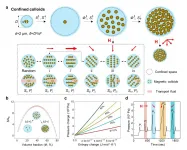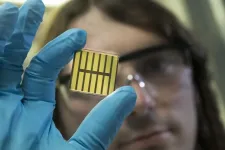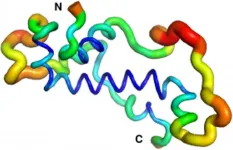(Press-News.org) ITHACA, N.Y. - A new Penn State and Cornell study describes an effort to produce the most comprehensive and high-resolution map yet of chromosome architecture and gene regulation in yeast, a major step toward improving understanding of development, evolution and environmental responses in higher organisms.
Specifically, the study mapped precise binding sites of more than 400 different chromosomal proteins in the yeast genome, most of which regulate the expression of genes.
Yeast cells provide a simple model system with 6,000 genes, most of which are found in other organisms, including humans, making them excellent candidates for studying fundamental genetics and complex biological pathways.
The paper, "A High-Resolution Protein Architecture of the Budding Yeast Genome," published March 10 in the journal Nature.
"It's a vastly more complex proposition, but like the sequencing of the yeast genome preceded the sequencing of the human, I'm sure we will be able to see the regulatory architecture of the human genome," said senior author B. Franklin Pugh '83, professor of molecular biology and genetics in the College of Arts and Sciences and a former professor at Pennsylvania State University, where he began this work. Matthew Rossi, a research assistant professor at Penn State, is the paper's first author.
The team used a technique called ChIP-exo to map the binding locations of about 400 different proteins that interact with the yeast genome, some at a few locations and others at thousands of locations.
The team performed more than 1,200 individual ChIP-exo experiments, producing billions of individual data points. Analysis of so much data required use of Penn State's supercomputing clusters and the development of several novel bioinformatic tools to identify patterns and reveal the organization of regulatory proteins in the yeast genome. The analysis revealed a surprisingly small number of unique protein assemblages that are used repeatedly across the yeast genome.
The study revealed two distinct gene regulatory architectures, expanding the traditional model of gene regulation. So-called constitutive genes - those that perform basic "housekeeping" functions and are nearly always active at low levels - required only a basic set of regulatory controls, whereas those activated by environmental signals, known as inducible genes, had a more specialized architecture.
The traditional model of gene regulation involves proteins called "transcription factors," which bind to specific DNA sequences to control the expression of a nearby gene. However, the researchers found that "housekeeping" genes - which comprise the majority of genes in yeast - lacked a protein-DNA architecture that would allow specific transcription factors to bind, a hallmark of inducible genes.
"The resolution and completeness of the data allowed us to identify 21 protein assemblages and also to identify the absence of specific regulatory control signals at housekeeping genes," said co-author Shaun Mahony, assistant professor of biochemistry and molecular biology at Penn State. "The computational methods that we've developed to analyze this data could serve as a jumping-off point for further development for gene regulatory studies in more complex organisms."
INFORMATION:
Co-authors included assistant research professor William K.M. Lai and postdoctoral researcher Chitvan Mittal, both of the Pugh Lab; Gretta D. Kellogg, director of Cornell's Biotechnology Resource Center Epigenomics Facility; and Penn State researchers Prashant K. Kuntala, Naomi Yamada, Nitika Badjatia, Guray Kuzu, Kylie Bocklund, Nina P. Farrell, Thomas R. Blanda, Joshua D. Mairose, Ann V. Basting, Katelyn S. Mistretta, David J. Rocco and Emily S. Perkinson.
This work was supported by the National Institutes of Health, the National Science Foundation, the Penn State Institute for Computational and Data Sciences, and computation from Penn State's Roar supercomputer.
Around three times as many males are diagnosed with autism than females. This suggests that biological sex factors may play a role in the development and presentation of autism.
Studies on the neurobiology (brain biology) of males and females with autism have begun to examine brain networks but results have been mixed. This is largely due to the limited availability of data from autistic females.
In response, researchers from END ...
Humans rely on nature extensively for everything from food production to coastal protection, but those contributions might be more threatened than previously thought, according to new findings from the University of Colorado Boulder.
This research, out today in Nature Communications, looked at three different coastal food webs that include those services provided to humans, or ecosystem services, and found that even if the services themselves aren't directly threatened, they can become threatened when other species around them go extinct--often called secondary ...
More than one million operations are performed in Switzerland every year. A surgeon's skill has a direct impact on the outcome of the operation. Training and experience, as well as momentary fatigue and other influencing factors all play a role. At present, skill is tested by experts, either directly during an operation or by evaluating video footage. This approach is very costly and only a limited number of experts are available. Moreover, the assessment may vary and is not always fully reproducible. For some time, attempts have been made to automate and objectify the assessment of surgeons' skills.
Proof of feasibility
The key result of the study is the proof of the fundamental feasibility of an ...
Colloidal suspensions of microscopic particles show complex and interesting collective behaviors. In particular, the collective dynamics of colloids is fundamental and ubiquitous for materials assembly, robotic motion, microfluidic control, and in several biological scenarios. The collective dynamics of confined colloids can be completely different from that of free colloids: for instance, confined colloids can self-organize into vortex structures, coherent motion, or different phase behaviors. On one hand, due to the complexity of colloidal suspensions, how to finely tune the ...
As the world continues to grapple with the COVID-19 pandemic, an international team of researchers have published a review of the best techniques to collect airborne aerosols containing viruses.
In the review, which was published by the Science of the Total Environment journal, a team led by the University of Surrey concluded that the most effective way to collect and detect airborne pathogens, particularly viruses, was to use cyclone sampling techniques.
For example, the sampler draws the air through the cyclone separator. It then uses centrifugal forces to collect the particles on a sterile cone containing the liquid collection vessel, such as DMEM (Dulbecco's minimal essential ...
Photovoltaics decisively contributes to sustainable energy supply. The efficiency of solar cells in directly converting light energy into electrical energy depends on the material used. Metal-halide perovskites are considered very promising materials for solar cells of the next generation. With these semiconductors named after their special crystal structure, a considerable increase in efficiency was achieved in the past years. Meanwhile, perovskite solar cells have reached an efficiency of up to 25.5 percent, which is quite close to that of silicon ...
Proteins are the key component in all modern forms of life. Haemoglobin, for example, transports the oxygen in our blood; photosynthesis proteins in the leaves of plants convert sunlight into energy; and fungal enzymes help us to brew beer and bake bread. Researchers have long been examining the question of how proteins mutate or come into existence in the course of millennia. That completely new proteins - and, with them, new properties - can emerge practically out of nothing, was inconceivable for decades, in line with what the Greek philosopher Parmenides said: "Nothing can emerge from nothing" (ex nihilo nihil fit). Working with colleagues from the USA and ...
The Cabeza de los Gatos waste rock pile, left from mining activities in the town of Tharsis (Huelva), underwent a rehabilitation process consisting of remodelling the slope of the pile, applying liming materials and then a layer of soil. Finally, trees and shrubs typical of the area were planted and a hydroseeding with a mixture of shrub and herbaceous seeds was applied. Twelve years later, a study led by researchers from IRNAS-CSIC, in collaboration with Sabina Rossini Oliva, a researcher from the University of Seville and the Environment and Water Agency of Andalusia (AMAYA), has proven the effectiveness of this sort of rehabilitation.
"The results obtained show that the steps taken were successful. Now, ...
People with high levels of emotional intelligence are less likely to be susceptible to 'fake news', according to research at the University of Strathclyde.
The study invited participants to read a series of news items on social media and to ascertain whether they were real or fictitious, briefly describing the reasons for their answers. They were also asked to complete a test to determine their levels of emotional intelligence (EQ or emotional quotient) and were asked a number of questions when considering the veracity of each news item.
Researchers found that those who identified the types of news correctly were most likely to score highly in the EQ tests. There was a similar correlation between correct identification and educational attainment.
The ...
In asthma, the airways become hyperresponsive. Researchers from Uppsala University have found a new mechanism that contributes to, and explains, airway hyperresponsiveness. The results are published in the scientific journal Allergy.
Some 10 per cent of Sweden's population suffer from asthma. In asthmatics, the airways are hyperresponsive (overreactive) to various types of stimuli, such as cold air, physical exertion and chemicals. The airways become constricted, making breathing difficult.
To diagnose asthma, a "methacholine test" is commonly used to determine whether a person is showing signs of airway hyperresponsiveness. Methacholine binds to what are known as muscarinic receptors in the smooth muscle cells lining the inside ...



